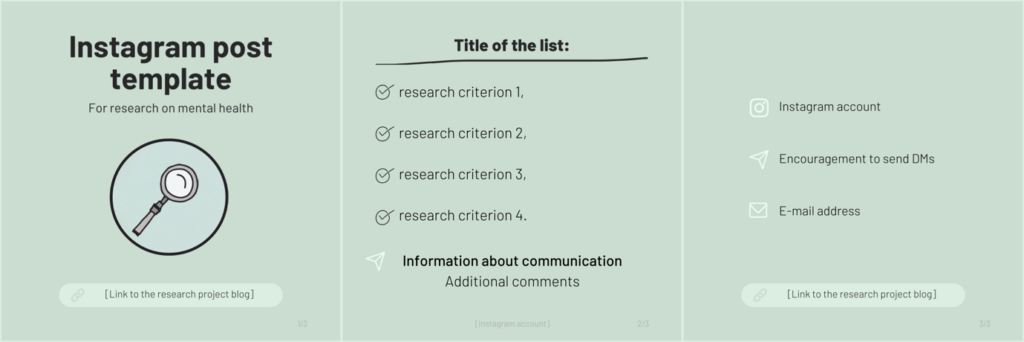In this post, ENPA board member Ildze Jakunova shares her experiences using digital technologies, such as social media, graphic design, and AI tools, to promote her doctoral research project and the fieldwork process online.

Figure 1 Visual elements used in the online presentation. All were created in collaboration with an AI image generator.
In 2023, I embarked on ethnographic fieldwork in Riga, Latvia, focusing on self-care practices among young people with recent experiences of depression and anxiety. Given the fragmented nature of my research design – working with people unconnected to each other – I decided to use online spaces for communication and recruitment. I created an elaborate online presentation to provide information about my research and encourage engagement. With this approach, I wanted to foster trust, display transparency and offer a visually pleasing insight into my work for potential research participants and other interested parties.
To achieve my objectives, I used multiple digital platforms, with a WordPress blog and an Instagram account serving as primary outlets. The blog provided a space to share comprehensive information about my project, including its aim, methods, timeframe, ethical considerations, and researcher’s background. On the other hand, Instagram offered a platform for concise, aesthetic, and easily shareable research updates and recruitment messages. In addition, I leveraged personal social media accounts to re-share information. I also used tools like Canva, Adobe Express, and the AI image generator Dall-E to synthesize visual material. The multi-platform strategy allowed me to relay information about my project while maintaining a clear message and reaching the target audience.
I designed a unique logo to establish a unified visual identity for my research. Due to my limited skills in graphic design, I used my sketches and AI technologies to my advantage. I began by creating a sketch on my tablet, drawing the main elements I would like to include in my logo and featuring symbols like a bike for physical activity and a heart for health. After that, I uploaded these sketches on the Dall-e system, creating variations of my designs. After several iterations, using my favourite sketch variants, I landed on a logo that best represented my project. I integrated this logo into my blog page and Instagram profile, and it also informed the design of the Instagram post template. You can see the logo development process in the image below.

Figure 2 Logo development process, using Dall-E.
I applied the same image generation method for other visuals, such as a looking-glass icon for interlocutor recruitment calls. You can see the result in the first and the third figure.
Unfortunately, the latest version of Dall-e no longer supports the feature of generating images from existing ones and has phased out free credits. A similar feature is still available, using Midjourney, but the setup process is more complicated. Alternatively, platforms like BingAI offer image generation from text prompts, but it is crucial to consider the influences AI systems draw on when creating images. This approach may not provide as much room for personal expression as using your own sketches might. Thus, I suggest keeping up with the future versions of ChatGPT in hopes that it will incorporate this option.
To recruit interlocutors, I primarily used calls for participation, which I posted on the project’s Instagram account. I also shared information through personal Instagram, X/Twitter, and Facebook profiles. The calls outlined the research purpose, methods, selection criteria, and confidentiality principles and linked detailed information about the study. Looking back at the recruitment process, I found Instagram and X/Twitter to be the most useful in reaching potential participants, thanks to their sharing-friendly features and the user base.
Via the Instagram account, I created carousel posts about my project and recruitment process and encouraged people to share them. Below is an example of a post template I made using Canva. This platform is helpful for developing content because it provides the standard formats and templates for popular social media sites.

Figure 3 The template used for Instagram posts. Created on Canva.
Post-fieldwork, I decided to maintain the blog and Instagram account to keep the connection with my interlocutors and the public. Currently, I post only when I have some updates to share about my progress, so the amount of labour is not critical. However, it is essential to communicate this with the audience to set expectations.
When receiving positive comments from interlocutors about the project presentation, I remember joking with them about my dual role as a researcher and a marketing specialist. As they say, there is a grain of truth in every joke. While I lack formal training in marketing, social media or graphic design, the ability to aptly present my research online was beneficial in reaching interlocutors and providing information. Furthermore, this strategy also sharpened my skills to articulate and showcase my project in a concise, clear, and visually pleasing manner. Given the positive feedback and valuable presentation experience, I consider my approach successful and intend to incorporate these insights into future research endeavours, if necessary.
At the same time, I acknowledge that my approach required a lot of time and effort. I also had previous experience creating social media content for professional and personal reasons. Therefore, extensive project presentations online may not be suitable for everyone, particularly those with busy schedules. Nonetheless, I recommend venturing down this path, even purely as a skill-building exercise. The digital landscape provides a unique opportunity for elevating research and presentation practices, and its potential should not go unnoticed.
About the author

Ildze Jakunova is a PhD student at the University of Helsinki. Her research explores mental health and care in Latvia, focusing on self-care and self-making.
Ildze is also responsible for ENPA communication activities.

Leave a Reply